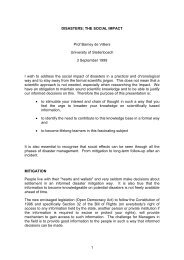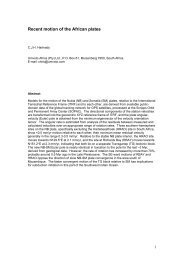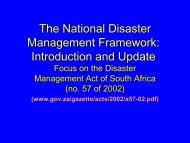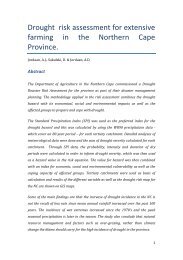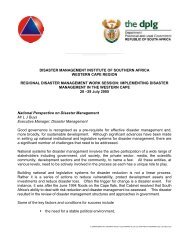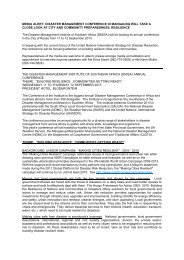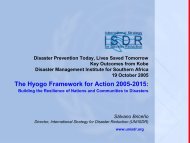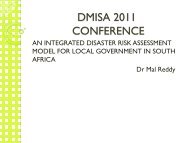BS Ngcamu, Dr. N Dorasamy - Disaster Management Institute South ...
BS Ngcamu, Dr. N Dorasamy - Disaster Management Institute South ...
BS Ngcamu, Dr. N Dorasamy - Disaster Management Institute South ...
- No tags were found...
You also want an ePaper? Increase the reach of your titles
YUMPU automatically turns print PDFs into web optimized ePapers that Google loves.
community organisations in the matters of local government”. Municipalities have an obligation tocapacitate civil society through training and skills related to different hazards such as first aid, firefightingand communication.The changes in <strong>South</strong> Africa’s disaster management policy and legislation unfolded during a periodof massive legislative reform in post-apartheid <strong>South</strong> Africa. <strong>Disaster</strong> management legislativereforms in <strong>South</strong> Africa took 11 years, from June 1994 to April 2005. There were a number ofdistinct phases in this development, namely, the Green Paper on <strong>Disaster</strong> <strong>Management</strong> (February1998); White Paper on <strong>Disaster</strong> <strong>Management</strong> (January 1999); <strong>Disaster</strong> <strong>Management</strong> Bill (58-2001in September 2001); <strong>Disaster</strong> <strong>Management</strong> Bill (B21-2002 in May 2002); <strong>Disaster</strong> <strong>Management</strong> Act(No. 57 of 2002 promulgated in January 2003) and the National <strong>Disaster</strong> <strong>Management</strong> Framework(April 2005).The major accomplishment of the legislative reform process in <strong>South</strong> Africa was the transformationof the policy of disaster-risk management (NDMC, 2006/2007:25). Influenced by New Public<strong>Management</strong> (NPM), the <strong>South</strong> African government embarked on legislative transformation withthe promulgation of the <strong>Disaster</strong> <strong>Management</strong> Act 57 of 2002. NPM has selected applicationswhich include decentralising disaster management from national government down to localgovernment. Decentralising management, disaggregating and downsizing of public services arestrands of NPM derived from “managerialisms” (Mellon, 1993; Hood, 1991 and Ferlie et al.1969:34). The public sector in general and public officials were also expected and encouraged to beresults-oriented. Governmental managers have to increasingly evaluate and make necessaryadjustments to all developmental projects so that they are able to involve risks, vulnerabilities andcapacities (Dwivedi, 1994:4). Government managers will have to consider all other aspects ofdisaster management which included relief operations, rehabilitation, reconstruction, mitigation,development and preparedness planning, should their developmental projects be affected by anydisaster. They further have to participate in joint consultation and co-operation with otherdepartmental heads, NGOs and other stakeholders to ensure that every disaster management issuewas addressed. The argument made by Thornhill (n.d.), in his discussion on the prerequisites forimproved service delivery, is that officials in managerial positions should be able to operate withina sound administrative system, supported by equally sound managerial practices. Furthermore,managers should be capacitated to perform their managerial functions efficiently, for instance, theyshould be enabled to take decisions, to exercise discipline and to demand accountability from alltheir staff.10



